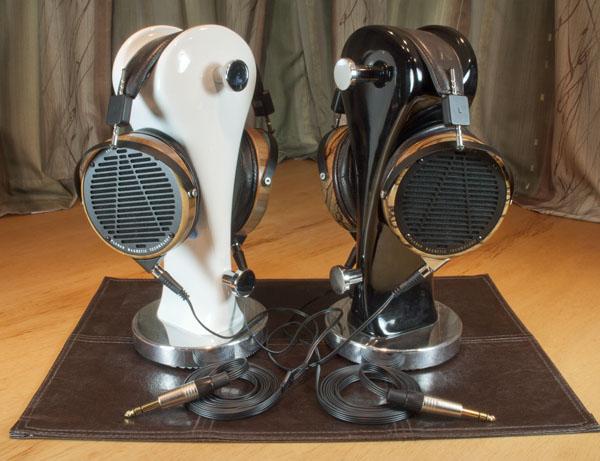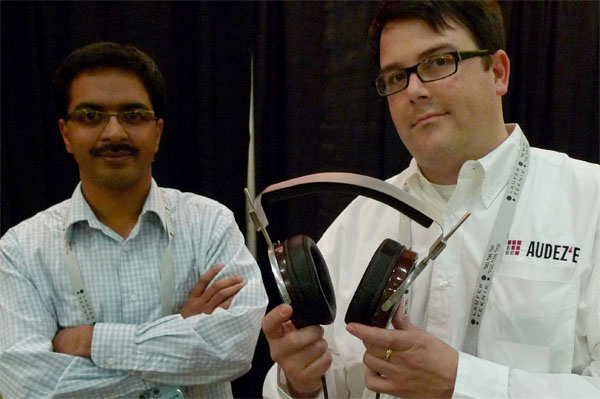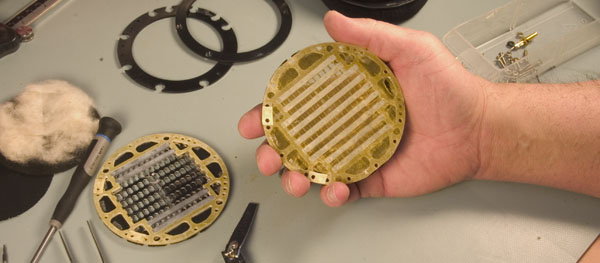| Columns Retired Columns & Blogs |
The Spectacularly Yummy Audeze LCD-2 and LCD-3

This story originally appeared at InnerFidelity.com
Introduction
Alexander Rosson and Sankar Thiagasamudram were just a couple of headphone enthusiasts a few years ago when they decided to have a go at building a new generation of planar magnetic headphones. They showed their first prototype driver design shoe-horned into another headphone housing at CanJam LA 2009. By October of that year, Audeze was showing their first complete product, the LCD-1.

Sankar (left) and Alex show off the LCD-2 prototype at CanJam at RMAF 2009.
Eight months later, I brought my headphone measurement system to CanJam Chicago 2010. When the guys from Audeze brought in their latest creation, the LCD-2, for measurement I was stunned with the results. In a number of ways it was the best headphone I'd ever measured. The bass extension was simply extraordinary.
In the years since, the LCD-2 has evolved: pads changed; the wood of the housing has changed; the headband has changed; and even the driver has evolved to the point that a new model, the LCD-3, emerged with a significantly thinner diaphragm. Through it all, one thing remained the same: these headphones were very good, and becoming tantalizingly closer and closer to world-class performance. But there was always a "but..."
Initially, the pads were too stiff, somewhat uncomfortable, and provided an unreliable seal for some. The treble was a bit too rolled-off as well. Then the pads were fixed, which improved the sound and comfort somewhat, but the wood housings would sometimes crack. The headband changed, connectors were added to prevent wood cracking, and pads were improved again. When the LCD-3 first came out, some problems with consistency and reliability arose.
Response to the problems and rapidly evolving Audeze products within the headphone community was predictably raucous. But I have to say, it's not that other companies don't have their own troubles as well. HiFiMAN, which was also developing competitive planar magnetic designs during the same time period had a rapidly changing product line and problems of its own. I've measured Beyerdynamic models that change significantly during the introduction period. And even Sennheiser lofts bloopers into the market every now and then (e.g., the new HD 700). But the guys at Audeze were one of our own, they had a great sounding can in the works, and dag nub it, we all wanted to see them pull off the miracle. Flames and exploding heads on the internet is encouragement of a kind...isn't it? Bottom line: I think a lot of the vocal reaction to Audeze's efforts, both positive and negative, were due to the fact that the headphone geeks really wanted Audeze to succeed, and it rankled when they struggled to hit the mark.
Through it all, however, to their great credit, Alex and Sankar kept their noses to the grindstone and worked tirelessly to respond to customers, made good on the promise of a quality pair of headphones, and continued to improve the quality of manufacture and performance. Today, I would argue, these two gentlemen have indeed arrived at a place where they can say with confidence that Audeze makes world-class headphones.
The Audeze LCD-2 ($995) and LCD-3 ($1945) Planar Magnetic Headphones
The thin and flat plastic membrane of planar magnetic headphone driver differs significantly from the domed diaphragm and voice coil of a typical headphone driver, which is more like a traditional cone speaker. The planar magnetic driver membrane has a serpentine pattern of conductor bonded to its surface, and is immersed in a very strong magnetic field provided by rare earth bar magnets within the driver housing.

The magnet structure of some HiFiMAN planar magnetic headphones, which are similar to the Audeze design.
The advantages of this design is that--like electrostatic speakers--the force moving the diaphragm is distributed over the entire surface, and it tends to move with a clean piston motion and with very little chance of modal break-up. The magnets are very strong, and the electro-motive force moving the diaphragm is very efficient and moves the diaphragms with significant force--here it has an advantage over electrostatic designs where the electrostatic force used is significantly weaker. However, a disadvantage of planar magnetic drivers is that the magnets and support frame for the magnets tend to be rather large and provide some acoustic interference--unlike electrostatic speaker stators which can be thin and more acoustically transparent. (For a complete description, see my InnerFidelity article "How Planar Magnetic Headphones Work")
Another disadvantage to the current crop of planar magnetic headphones from Audeze (and HiFiMAN) is that because of the size and weight of the drivers the headphones are large and rather heavy. Fortunately, Audeze has worked hard on the headphone ergonomics and despite their heft, the LCD-2 and LCD-3 are quite comfortable. No dancing though, these are headphones for sitting and listening.
Let's talk about the build...
- Log in or register to post comments




































